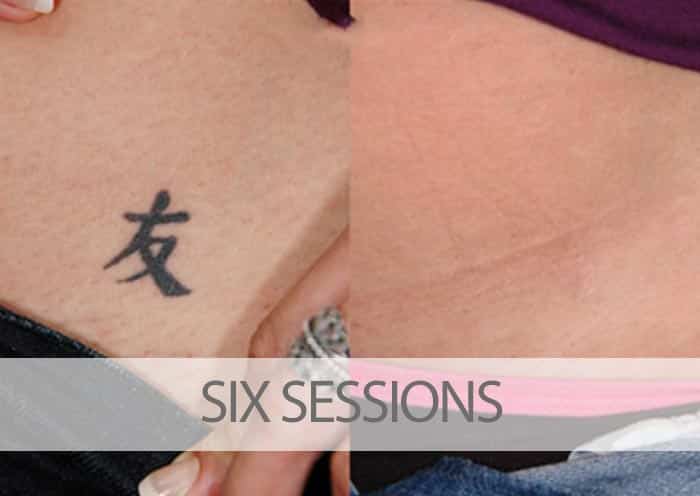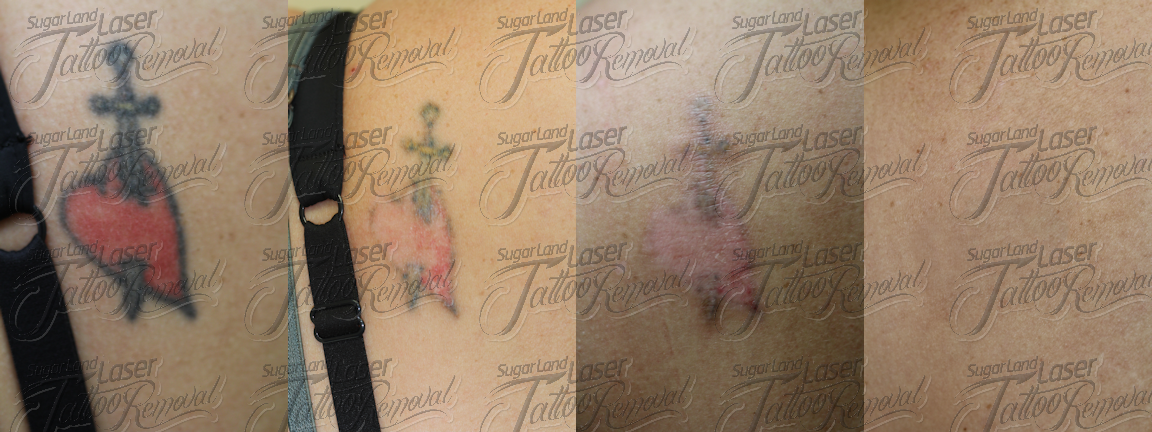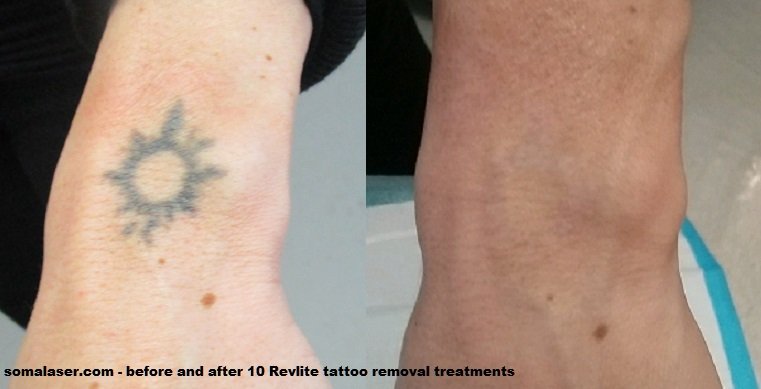Black, red, dark orange and dark blue tattoos will usually respond relatively quickly to laser treatments. Green, purple, brown, light orange and light blue may require more visits. Our all new Picosure and RevLite® lasers are much more effective than older lasers at removing multicolored tattoos. We will use the lasers that are most successful for your particular tattoo. Dark inks usually respond quicker than bright colored inks because dark colors absorb laser energy better.
Light colors such as light green, yellow and turquoise can be difficult to remove, however, our all new Picosure laser is much more effective at removing these colors than older models. Sometimes chemicals like iron oxide or titanium dioxide are added to tattoo ink to brighten the tattoo - but these chemicals make it much more difficult to remove the tattoo. Fluorescent "Day Glow" pigments are almost impossible to remove.
Some tattoos are now made with dark tar-based ink or "laser resistant ink" and these tattoos can only be removed by cutting them out. PicoWay by Syneron Candela is the latest most advanced picosecond laser used to treat tattoos of ALL colours. Using advanced picosecond technology the PicoWay shatters tattoo ink into miniscule particles which is cleared by the body's immune system. With less discomfort during and after the treatment, tattoo removal sessions can be spaced closer together. Your tattoo is treated effectively and in fewer treatments. View our extensive portfolio below of tattoo removal before and after photos provided by leading dermatologists and aesthetic providers from around the world.
Send us the photos and the treatment details to ourmailboxand we'll happily publish it too. It normally can take between 4-8 laser treatments for a successful removal of a tattoo. The exact number greatly depends on the age of the tattoo, the patient's pain tolerance and skin type and genetic factors. Therefor we encourage you to send photos that were taken after each session and not only at the beginning and end of the treatment process. Some patients choose to only remove the tattoo partially, as they want to cover it with a new tattoo so less treatment sessions are required in this case. Both your skin type and the colors which comprise the tattoo will determine the complexity of your tattoo removal.
Black or darker ink tattoos are easier to treat, whereas pink or yellow tattoos are somewhat more challenging. Regardless of the size or color of the tattoo, laser treatment will always require a series of sessions in order to completely remove the tattoo. Generally, at least eight to twelve sessions will be required and for more colorful and larger tattoos, more sessions might be needed.
We strive to ensure that each patient is informed about what to realistically expect when coming in for a laser tattoo removal session. Our non-invasive PicoWay laser uses highly concentrated soundwaves, which are fired rapidly to target the tattoo ink. The laser focuses its energy on one spot, and is able to break the ink pigment into much smaller particles.
Then, over time, the body naturally eliminates the microscopic ink particles, clearing the tattoo ink. Our laser technology is regarded as the most effective and safest way to remove unwanted or outdated tattoos. The most common problem with laser tattoo removal treatment is incomplete fading or removal of the tattoo. This is mainly an issue with complicated multicolored tattoos.
Not all tattoo inks respond and rarely certain colors can get worse. Heavy professional tattoos in particular may not completely fade. Significant and sometimes irreversible darkening of tattoo ink may occur, where the pigment is impossible to remove. This is mostly a problem with flesh-colored, red, tan, and white inks, and a small test area can be done to detect this problem. Skin care after laser treatment of tattoos is quite similar to skin care after having a tattoo.
Gentle cleansing of the skin and application of an antibiotic ointment will help tattoos heal quickly after treatment. Watch for unusual redness, pain, or swelling which might be a sign of infection, and please call us right away if you think an infection is developing. The area may remain reddened for two to four weeks, and there may be some flaking or peeling during this time. Sometimes skin or a scab the same color as the tattoo peels off after 5-7 days. This is a normal process as the body works to eliminate the tattoo dyes.
Very dark, or large professional tattoos, will remain tender and swollen for a few days.There may be some lightening or darkening of the skin for several months after laser treatment. Protect the treated area from sun exposure until the skin is completely healed and the skin color has returned to normal. Laser treatment is the most common method of tattoo removal and is the method recommended by Dr. Mylissa. While getting a tattoo is relatively straight forward, the removal of the same tattoo is a much more complex process.
Laser treatments offer the most effective means for removing an unwanted tattoo. Dr. Mylissa utilizes the Candela Alex-Trivantage® laser because it is equipped with multiple wavelengths and treats all colors of tattoos including red, blue, green and black tattoos. This laser also treats patients of all skin types including patients with dark skin. Laser tattoo removal is considered to be the best method to remove unwanted tattoos because it's the safest and most effective technique available today. Professionals use a specialized laser to target the colored ink in your skin, and the heat from the laser breaks the pigment particles apart into smaller pieces.
Your body then removes those ink particles over time using natural processes. With laser tattoo removal, you'll have few if any side effects like blistering, swelling, itching or discomfort. Laser tattoo removal requires fewer and faster treatments and has the greatest success in removing most tattoo colors. Unwanted dark and multi-colored tattoos can be safely and effectively eliminated with Alma's variety of tattoo removal treatments.
These are clinically proven laser treatments which use a various laser wavelengths that target different ink colors. High-intensity light beams create a photo acoustic shock wave that breaks up the ink particles in the tattoo. The result after a number of sessions reveals clear, ink-free skin with minimal risk of scarring or hypo-pigmentation. A Fellow of the American Society for Laser Medicine and Surgery, Dr. White has specialized in cosmetic laser treatments for more than 10 years. Quick fading or removal can sometimes be accomplished on black tattoos by using low powered treatments every week or two. In general, however, it is best to wait at least 6 weeks between laser tattoo removal treatments.
You should think of the fading and eventual elimination of your tattoo as a project which you might work on from time to time over the next year or two. Dr. White will explain what is likely to happen, but she cannot precisely predict or guarantee what will happen in any particular case. Dr. White will also show you photos illustrating the range of results, from fading through to complete disappearance of the tattoo. Patients should be counseled that tattoo clearance is often incomplete and a residual tattoo outline and textural changes may be seen .
An online questionnaire with 157 participants post tattoo removal showed that only 38% achieved complete tattoo removal. Local reactions following tattoo removal occurred in 97% of participants, and include blistering, edema, crusting, erythema, and pain. Permanent side effects can occur, and include scarring, hyper- or hypopigmentation , and color change of tattoo pigment. Patients with darker skin type are at a higher risk of complications. Skin textural changes are not uncommon and follow multiple laser treatments post treatment . The Revlite laser is still considered the "gold standard" for nanosecond laser tattoo removal, and we find it very effective on removing red ink pigment in tattoos.
PicoSure is the world's first and only picosecond aesthetic laser cleared by the FDA. Even difficult ink colors such as blues and greens, as well as previously treated tattoos, can be removed in fewer treatments with better clearance and improved recovery time. We also use RevLite for removal of red pigment tattoo inks. Older technology such as the Medlite C3 and C6 often left a ghost of the image making it difficult to replace the image or having to cover up the residual tattoo. QS alexandrite laser has also been found to be safe and effective for tattoo removal in darker skin types. Burkhari et al. treated 20 Arabic women with skin type III-IV and achieved more than 95% lightening in 5 patients, and more than 75% lightening in 10 patients.
These patients were given 3-6 treatments at 6-12 week intervals. Pinpoint bleeding was observed in one case but no pigmentary alteration or scarring was seen. Tattoo removal is a safe and effective method that uses a laser to remove unwanted tattoos. A beam of light can help significantly lighten the appearance of your tattoo or completely remove it. The tattoo removal laser treatment is less extensive as other conventional tattoo removal methods like cryosurgery, dermabrasion, or excision, and reduces the likelihood of scarring.
All of these photos were taken in our office directly after each client's first and last consultation with us. Non-ablative or ablative fractional resurfacing has been reported to be effective for tattoo removal, either when combined with QS ruby laser treatment or as monotherapy. It appears to enhance pigment clearance, prevent blistering, shorten recovery and diminish treatment-induced hypopigmentation.
It has also been reported to be effective for the treatment of traumatic, allergic, and multicolored tattoos. Such fractional resurfacing can be combined with the traditional QS lasers for a synergistic effect. But some ink colors and types require additional treatments.
The easiest ink to remove is black, as it is easy to match the laser wavelength to black. Other colors such as red, blues, and greens can become more difficult to remove. There are no guarantees, but even the most stubborn tattoo can be dramatically lightened with laser treatment.
Since the advent of laser tattoo removal, darker ink colors like green, blues and some reds have been difficult to remove entirely. Mostly, it's because the earlier lasers didn't have the right energy wavelength or speed to do the job. These colors are often are what's left after a series of removal treatments with the early Q-Switch lasers. However, with the PICO laser technology, this is no longer an issue. In fact, by starting with a fast, more powerful laser like the PICO, the length of time to remove these colors is shortened, significantly – one-third to one-half the amount of time. When you choose this treatment, you can rest assured that you will benefit from the highest safety standards and the most effective means of removing ink.
Our lasers are FDA approved and have helped many patients get rid of their unwanted tattoos without harmful methods. In the past, many tattoo removal treatments yielded spotty results. Today, our advanced lasers can treat all colors faster and more completely than ever before.
Picosecond lasers, with pulse duration of 10−12 seconds, are the newest lasers promising fast and efficacious tattoo removal. When you get close to your tattoo removal session, avoid direct sunlight exposure to your tattoo. Exposure to UV rays from the sun can stimulate the production of vitamin D and melanin, which can affect how your body responds to light waves during laser treatment. The question of how long the entire process takes isn't a simple answer. Newer tattoos take a little more time, as the ink is new and has not broken down at all. Plus, the size, color, and type of ink used all play a role in how easy it is to remove the tattoo.
Black and red are the easiest colors to remove; turquoise is the most difficult single color to target. All tattoos have layers of ink that are stacked on top of each other within the skin. Shaded areas clear more quickly because those areas have a lower ink density. Older tattoos can be removed with fewer treatments than newer tattoos.
In the past, certain blues and greens of tattoos were not easy to remove. PicoSure laser tattoo removal system effectively removes a spectrum of tattoo ink colors. Aesthetica clients have seen amazing results from PicoSure even if they have tried to get their tattoo removed before with other Salt Lake City laser tattoo removal systems.
Tattoo ink lives underneath the top layer of skin, which makes it difficult to remove, often requiring multiple laser sessions or in some cases, surgical removal. Laser tattoo removal is a noninvasive procedure that uses a Q-switched laser device to break down the pigment colors of an unwanted tattoo, while causing minimal damage to surrounding tissue. Laser tattoo removal has become more and more popular as the prevalence of tattoos has increased over recent decades. Not all lasers are the best for all skin types and all tattoo colors.
So try to find a tattoo removal photo that is your same skin type, with similar ink density, and the same ink colors. For the first half-hour after laser tattoo removal treatment the tattoo looks pale or white, and may swell slightly. The tattoo may feel hot for a while after laser treatment, and it will probably be red and swollen for the rest of the day. There may be pinpoint bleeding for a few hours in areas where there was a lot of pigment. At Saratoga Dermatology, we use the Q-switched Alexandrite laser for tattoo removal treatments.
This laser represents a breakthrough for tattoo removal because earlier lasers could significantly lighten the skin for results that weren't cosmetically pleasing. The Q-switched laser can target different ink colors and is especially effective removing black or blue ink. The use of multi-pass treatments to reduce the number of treatment sessions has been explored.
The 20 minutes waiting time allows for the post-laser immediate whitening to resolve completely before a second pass is given. The authors hypothesize that such repeated passes allow for treatment of pigment in successively deeper layers of the dermis. Topical perfluorodecalin is a highly gas soluble liquid fluorocarbon that can resolve the whitening reaction within seconds.
These studies reported superior tattoo clearance with both the R20 and R0 methods, compared to traditional single pass laser treatment. A thorough history and examination are essential in establishing the type of tattoo and the skin type of patient prior to treatment. Previous isotretinoin treatment, systemic gold therapy, herpes infection, keloidal tendencies, and sun exposure habits should be considered, as additional precautionary measures may be needed. Standardized digital photography is helpful in recording the baseline appearance, and any subsequent improvement.


























